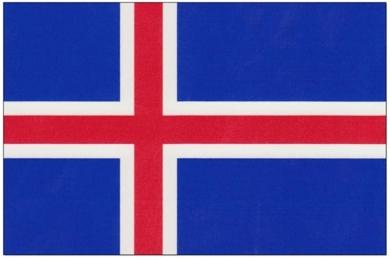Iceland was originally settled by immigrants from Norway. Opponents of the then King of Norway Harald fled to the island, who did not want to submit to his autocratic power. Settling the country, the settlers retained their social foundations, formed in "pre-state time." All issues were decided by the national assembly or within the clan community. Therefore, at that time the country did not have any centralized government, and as a result there was no need for such symbols of state power as the coat of arms and flag of Iceland. This form of government existed until the beginning of the XIII century, when Iceland was forced to recognize as the supreme power, first Norway, and then the Danish king.
The first mention of heraldry dates back to the Middle Ages. Then they were the personal emblems of the Icelandic knights and orders that had received this right, with which Iceland was then full. The emblem and flag usually contained images of animals (falcons, polar bears, etc.), whose spirits were believed to patronize knights.
At the same time, a heraldic element appeared, which is present on the modern state emblem, namely, the shield-bearing spirits, the guardians of all of Iceland: a giant, a bird, a bull, a dragon.
The first emblems of Iceland
Presumably the first official emblems of Iceland date back to 1265-1285. The heraldic atlases of that time depict the emblem of the king of Iceland, but in fact one of the emblems of the Norwegian monarch, whom the Icelanders swore allegiance to. The coat of arms is a scarlet lion with a battle ax on a shield. Also, a modified symbol of the then Norway is reckoned with the replacement of colors by the opposite. What flag Iceland had during this historical period has not yet been reliably established. The belonging of the found signs to Iceland is not exactly proven and causes controversy among historians and heraldists.
Cod on the coat of arms of Iceland
Presumably the first to use the image of cod as a symbol of Iceland on their seals was begun by merchants who traded and had their enterprises in this state. For the first time this image on the shield was found in a manuscript dating back to 1360, and later it was used as a coat of arms in all medieval documents. Whether the cod pattern was used as the flag of Iceland or not, is not currently established by historians.
The fish was depicted in the personal seal of the Danish King, intended for the Governor of Iceland. One of these silver prints depicting the crown and cod is exhibited at the National Museum of Iceland.
The use of this fish as a national symbol at that time had a good reason. Cod was the main trade and export product, and its appearance on the arms and seals looks quite justified. On the royal seal of Denmark, such a symbol of Iceland lasted until the first half of the 19th century, later it was replaced by the image of a falcon.
Coat of arms of the Kingdom of Iceland
In October 1903, by decree of the Danish king, a falcon on a blue background became the coat of arms. Residents saw in it a more appropriate national symbol than in decapitated fish. This proud bird was also applied to the Royal flag of Iceland. At the same time, the highest state award was established - the Order of the Falcon.
Iceland
In 1940, Hitlerite Germany completely occupied Denmark. At the end of the war, Iceland was occupied by the troops of the Anglo-American coalition, and the national council held a referendum, in June 1944 an independent Icelandic Republic was proclaimed.
It was decided to abandon the crown on the state emblem, but to preserve basic elements such as a shield and perfume-shield holders. A volcanic basalt slab was chosen as the base of the coat of arms.
An interesting fact: when discussing the coat of arms of the new republic, the authorities turned to the professional heraldists of the Vatican for advice. But they were so busy developing personal emblems for cardinals and bishops that they missed the chance to create a symbol for the whole state.
National flag
“Quitblown” (Isl. Hvítbláinn, translated “white-blue”) was the first national flag and was a rectangle with a dark blue background and a white cross. The country's right to have its own flag was confirmed by a decree of the King of Denmark on November 22, 1913, and already on June 19, 1915 the highest council (alting) approved a law determining what the flag of Iceland looks like. In the white cross was added another inner, red. Denmark recognized sovereignty within the framework of the union in 1918, and on February 12, 1919, the official flag of Iceland was approved by king’s decree. After the declaration of complete independence in 1944, radical changes to the flag did not occur, only the background color became darker. The drawing reflects Scandinavian traditions and is derived from the Danish state mark. The red color on it reminds that the country has long been under the protectorate of Denmark. White and blue colors are traditional and come from the symbolism of the Knightly Order of the Silver Falcon.

Also, the colors of the flag are associated with Icelandic landscapes: red is the fire of the volcanoes of Iceland, white is snow and ice, blue is the water of the Atlantic Ocean around the island.
State flag
In addition to the national one, there is also the national flag of Iceland, which is distinguished by the presence of a triangular notch at the free end. The length of the blue fields on the free part is three times the width. The days of mandatory raising of national and state flags are determined by special law.